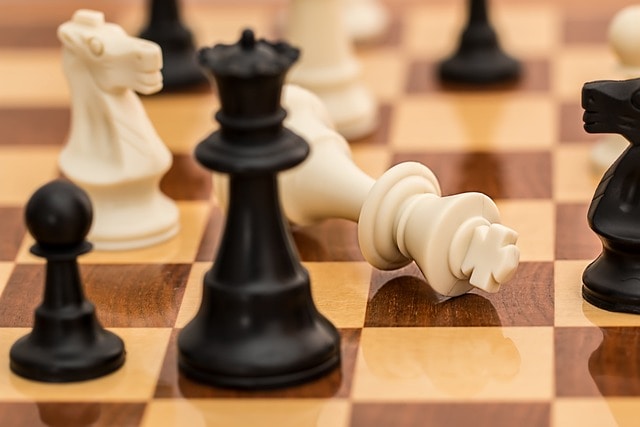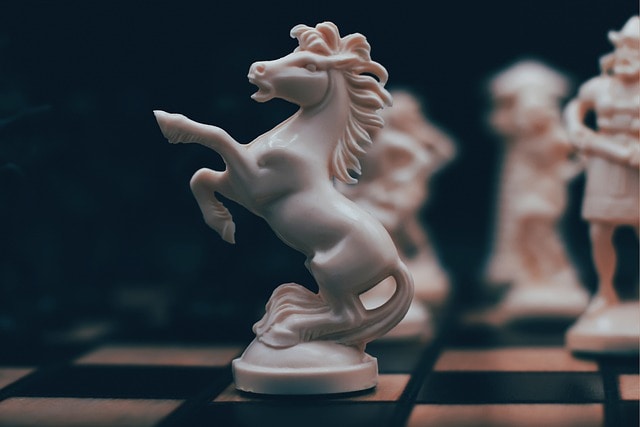How Many Pieces in Chess: A Quick Guide

Chess is a game which has had influence far beyond its general player base; anything from boxing to politics can sometimes be described as being “like a chess game” due to its famously strategic nature. Many people credit playing chess as being the reason they have been able to achieve so much in life, with the patience and concentration required to win a game being skills well worth honing. In order to understand the game of chess, it is important to first understand the pieces: what they are, what they do, and how useful they can be in the hands of a skilled player.
Introduction to Chess Pieces
Chess has been around for centuries - about 1450 years, in fact, with the first accounts of it being played dating back to the turn of the seventh century. It seems to have been a mutation of the ancient Indian game Chaturanga. The instantly recognizable board is set out with a mosaic of squares, 8x8, and usually in black and white although some custom chess sets will have different colors. The most important element of the game, though, is the part that you can control - the chess pieces themselves.
Whether you are new to the game or a seasoned expert, learning and improving at the game hinges on your understanding of the pieces. Mounting a successful defence or moving in to achieve checkmate will depend on how well you know what your pieces are doing, and just as crucially on your understanding of how your opponent is moving their pieces. All of the pieces on the board, Pawns aside, can do something special - and how you use your Pawns will influence how effectively you can marshall the more valued characters as the game develops.
Counting the Pieces in a Set

As we’ve noted, a chess board is eight squares by eight, and at the beginning of each game, the first two rows at either end of the board are occupied by the iconic pieces with which we play. Those pieces are named as follows:
- Pawns: There are eight of each, lined up in front of the other pieces.
- Rooks (or Castles): Shaped like the turret of a castle, there are two of these, placed in each corner of the board.
- Knights: Shaped like a horse, there are also two Knights, which sit next to the Rooks.
- Bishop: With the recognizable Bishop’s hat, two Bishops for each player sit inside the Knights.
- Queen: The most powerful piece on the board, the lone queen is placed on the fourth square from the left as seen by the player.
- King: The piece you must protect, the king sits to the left of the queen, and like the queen there is only one per player.
In total, then, there are sixteen pieces per player, for a total of 32 pieces on the 64 squares of the chess board. That’s at the start of the game, of course; as soon as the game gets going, these figures will start to come off the board in due course.
Exploring the Role of Each Piece
Each piece on a chess board has its own specific abilities and vulnerabilities, and their own roles to play in the tactics of the game. We will start by looking at the Pawn, which is the most plentiful piece on the board with eight on each side. In truth, the Pawn’s role is often as cannon-fodder; you expect to lose most if not all eight of them by the time a game ends - but if you can get one to the end of the board it becomes a Queen, and instantly more powerful. Pawns are typically used to clear other pieces off the board, and are often deliberately sacrificed by an attacking player to clear space in the opponent’s ranks.
The Rook is a very useful piece in attack, particularly if it has space in which to move; it can make decisive moves in a short space of time. Knights, which we will cover in more detail momentarily, are used most effectively by experienced players. Their movement is quite unlike any other piece on the board, but there is an added level of versatility allowed by its ability to “jump” over occupied squares, which makes it hard to defend against if it’s in use by a skilful player.
Bishops can be seen as a companion piece to the Rook, as they each move in a way that the other cannot; if you align them correctly, you can often end up teaming them to trap an opposing piece. The Queen is the most powerful piece due to her versatile movement, but you should always be aware of her position relative to the King. Although arguably the most important piece on the board (because the game ends if you lose it), the King isn’t very powerful tactically until right at the end of the game, and even then only in the hands of a skilled player. The term “Checkmate” comes from the Persian shah mat, which literally means “King dead”.
Special Abilities of Knights

As promised, we need to take more time to talk about the Knight’s role on the board. They move in an unusual way, making them hard to predict and keenly effective in the hands of a good player. Knights are the only piece on the board with the ability to “jump” over occupied squares, which makes them a highly-powered piece in games where the board becomes crowded. For novices they can be a bamboozling part of the game, because their L-shaped movement seems awkward, but once you’ve figured them out they can be lethal in attack.
As your tactical acumen becomes more developed, Knights become an influential part of the attack, being used in Knight forks where multiple opposition pieces are attacked at once. This can force an opponent onto the defensive or lead to them losing some of their more valuable pieces. If you can locate a Knight on an outpost, (ie. a position where it cannot be attacked and where it has a Pawn to defend it), this becomes a valuable spot from which to plan attacks. If you’re a beginner, chances are you’ll lose a lot of games anyway, so it is worth experimenting with the Knights and seeing just how useful they can be.
How to Move Each Chess Piece
The movements of each piece are the first and most important thing to learn about when starting out. Although the way pieces move might seem simple, there are intricacies you must know.
- Pawns can move two squares forward on their first move, and only then. After this, they can move one square, and only move forward, except when capturing another piece, when they move diagonally by a single square. They can never move backwards.
- Rooks can move forwards and sideways, and only through open squares. If they reach a square that is occupied by an opponent’s piece, they will capture it.
- Knights move in an L-shape - two squares forwards or sideways, and then one square at a right-angle to that. They are the only piece that can “jump” occupied squares.
- Bishops, like Rooks, can move only through open squares, and can move along diagonals, but only in one direction per move. Also like Rooks, they capture any opponent’s piece they touch.
- The Queen can move as many squares as are open, in any direction. This makes her immensely powerful as the game opens up, as she can attack from anywhere on the board; but she should always be in a position to move to the King’s defence if needed.
- The King can move in all the same directions as the Queen, but only through one square at a time.
Strategy Tips for Beginners

Chess is a complex game. Masters who have been playing for years still end up learning things they hadn’t realized before, so we can’t tell you every strategic tip you need to know; practising on 247chess.com will help you learn more. We can give you some tops to start with, though.
Control the center
The more pieces you have occupying the center of the board, particularly the squares d4, d5, e4 and e5, the more options you have for attack and the more flexible you can be in defending. Your pieces don’t have to be in the center at all times, but being within reach of it helps you control the game.
Develop your pieces
Moving your Rooks and Bishops into the more active areas of the board is something you should do as early as you can. This is known in chess as “developing”, and it simply gives you more room to make progressive moves - the longer they are stuck in their original spots, the less chance these key pieces have to influence the game.
Leave the Queen in place
The Queen can obviously make the greatest difference of all the pieces on the board, but that difference is more valuable the longer you hold off using it. Once a piece is moved out into the main board, it becomes vulnerable, and you can end up wasting moves just trying to protect and retreat the Queen at key points in the game, rather than attacking.
Co-ordinate your pieces
One key reason for learning what your pieces do and how you can use them is that, the better you get at doing this, the more you can co-ordinate them in an attacking cause. Learn how to progress Knights, Bishops and Rooks in tandem, and how to get every last move you can out of your Pawns, because if you can get more pieces into attacking positions, you can press the advantage in a meaningful way.
Conclusion: Mastering the Game
Every chess master was once a beginner, and everyone who has ever picked up a piece has made mistakes that would make them blush now. The only way you get good at chess is to play often and against anyone who’ll give you a game. The more you understand the pieces, the more you’ll be able to build your tactics and find new ways to win, because after a certain point, mistakes are the only way you learn. Take the chance to play, be brave and play to win; the more you do so, the better you’ll get.
Seasonal Chess Games
More Games
Chess News
Disclaimer
DISCLAIMER: The games on this website are using PLAY (fake) money. No payouts will be awarded, there are no "winnings", as all games represented by 247 Games LLC are free to play. Play strictly for fun.

































